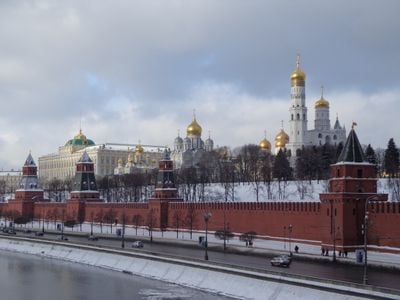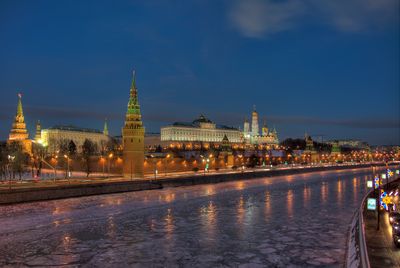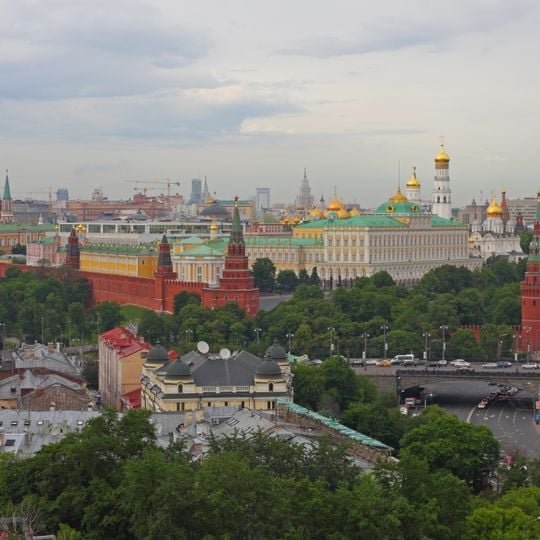
Kremlin, Fortified complex in Tverskoy District, Moscow, Russia
The Moscow Kremlin is a walled fortress complex covering approximately 28 hectares along the Moskva River, featuring government buildings, cathedrals, palaces, and defensive towers constructed from red brick with distinctive golden domes visible throughout the city.
Construction of the Kremlin began around 1420 under the direction of architects including Aristotile Fioravanti and Pietro Antonio Solari, evolving from a medieval fortress into the political center of Russian power where tsars were crowned and state ceremonies conducted.
The complex houses several important Orthodox cathedrals including the Assumption Cathedral and the Annunciation Cathedral, which preserve centuries of religious art, icons, and ecclesiastical architecture representing Russian spiritual traditions and artistic achievements.
The Kremlin is open to visitors daily from 09:30 to 18:00, with access to museums, cathedrals, and Cathedral Square available through guided tours, though certain government areas remain restricted for security purposes.
The Spasskaya Tower features a clock that has become a defining symbol of Moscow, its chimes marking official time for Russia and appearing in countless photographs of the complex taken from Red Square.
Location: Tverskoy District
Inception: 1420
Architects: Aristotile Fioravanti, Aloisio da Milano, Palace of Facets, Pietro Antonio Solari
Part of: Kremlin and Red Square
Address: Moscow, Russia, 103132 103073 Moscow
Opening Hours: Monday-Sunday 09:30-18:00
Phone: +74956970349
Website: http://kreml.ru
GPS coordinates: 55.75167,37.61778
Latest update: November 24, 2025 13:53
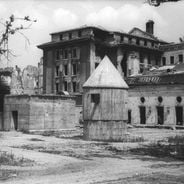
Military buildings from different countries demonstrate the evolution of defense structures and command centers across centuries. This collection includes medieval castles, early modern fortifications, barracks, command posts, and contemporary military installations. Each structure documents the military strategies, technological advances, and historical events of its era. The sites range from European fortress systems such as Vauban fortifications in France to Asian defensive walls and American military bases from various periods. Many of these structures played critical roles in wars and conflicts and are now accessible as monuments or museums. They provide insights into military architecture, engineering practices, and the strategic importance of their locations.
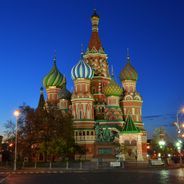
Moscow offers photographers numerous subjects: Saint Basil's Cathedral with its colored domes, the Bolshoi Theatre, the Kremlin and modern art galleries. The city combines historical architecture, parks, museums and contemporary buildings. From Stalin's skyscrapers to Zaryadye Park with its floating bridge, Moscow presents itself as a metropolis of contrasts.
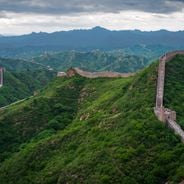
In 2007, the New Seven Wonders Foundation, led by Swiss businessman Bernard Weber in cooperation with the marketing company Deureka, organized a global vote, the results of which were announced on July 7 in Lisbon. This project, which was especially successful in India and China, enabled the designation of seven monuments representing different civilizations and eras, from antiquity to the 20th century. UNESCO stated in a release that it was not involved in this event, contrary to what many voters believed. The final selection includes sites across all continents: the Great Wall of China, a fortification system built over several centuries; Petra in Jordan, a Nabataean city from the 4th century BC carved into rose-colored rock; the Colosseum in Rome, a 1st-century amphitheater capable of holding 50,000 spectators; Chichen Itza in Mexico, a Maya site demonstrating the astronomical knowledge of this civilization; Machu Picchu in Peru, an Inca city from the 15th century located at 2,430 meters above sea level; the Taj Mahal in India, a white marble mausoleum built between 1631 and 1643; and the Christ Rédempteur statue in Rio de Janeiro, a 38-meter-tall monument inaugurated in 1931. The Khufu pyramid, the only remaining ancient wonder still standing, was removed from the voting list and designated an honorary wonder. The 21 candidate sites were selected by a commission of architects from five continents, chaired by Federico Mayor, former UNESCO Director-General. The criteria included aesthetics, architectural achievement, and historical significance. Each monument had to be constructed by humans, completed before 2000, and in acceptable preservation condition. This collection lists all monuments and allows users to view their locations and photos via individual records.
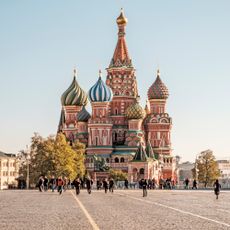
St. Basil's Cathedral
343 m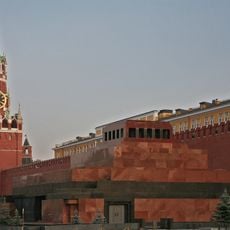
Lenin's Mausoleum
248 m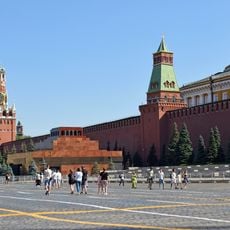
Red Square
311 m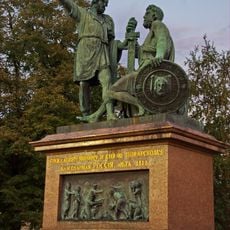
Monument to Minin and Pozharsky
329 m
Tsar Cannon
25 m
Tsar Bell
106 m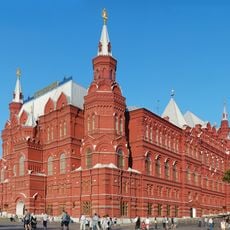
State Historical Museum
371 m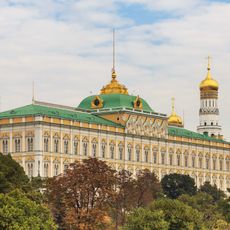
Grand Kremlin Palace
222 m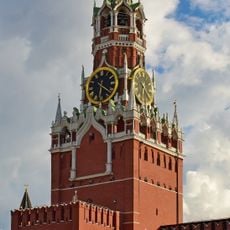
Spasskaya Tower
245 m
Cathedral of the Archangel
155 m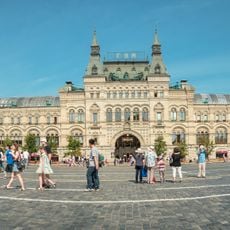
GUM
412 m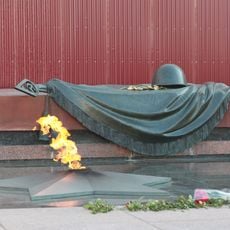
Tomb of the Unknown Soldier
356 m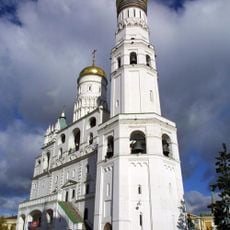
Ivan the Great Bell Tower
94 m
Palace of Facets
170 m
Kremlin Armoury
359 m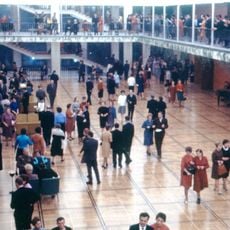
State Kremlin Palace
143 m
Cathedral of the Annunciation
198 m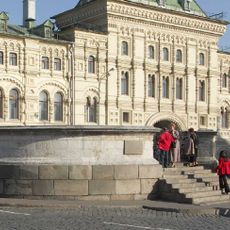
Lobnoye Mesto
349 m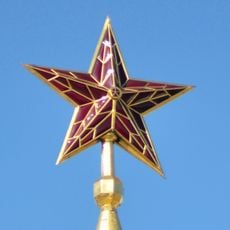
Kremlin stars
244 m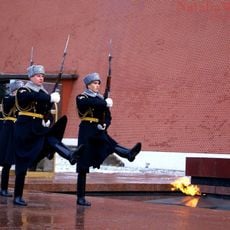
Post #1
382 m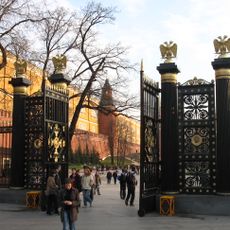
Alexander Garden
259 m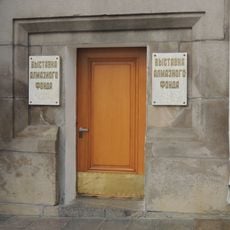
Diamond Fund
340 m
Moscow Kremlin Wall
287 m
Terem Palace
186 m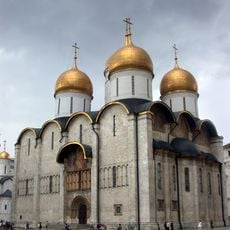
Dormition Cathedral
94 m
Kutafiya Tower
325 m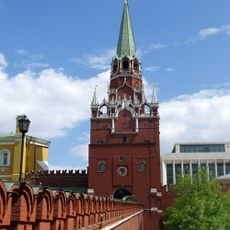
Troitskaya Tower
209 m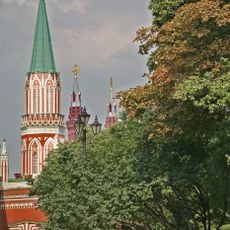
Nikolskaya Tower
313 mReviews
Visited this place? Tap the stars to rate it and share your experience / photos with the community! Try now! You can cancel it anytime.
Discover hidden gems everywhere you go!
From secret cafés to breathtaking viewpoints, skip the crowded tourist spots and find places that match your style. Our app makes it easy with voice search, smart filtering, route optimization, and insider tips from travelers worldwide. Download now for the complete mobile experience.

A unique approach to discovering new places❞
— Le Figaro
All the places worth exploring❞
— France Info
A tailor-made excursion in just a few clicks❞
— 20 Minutes

